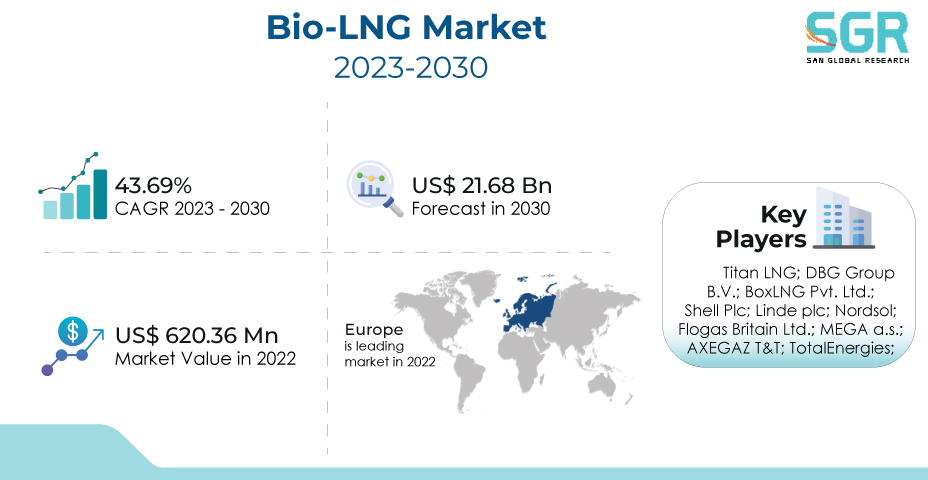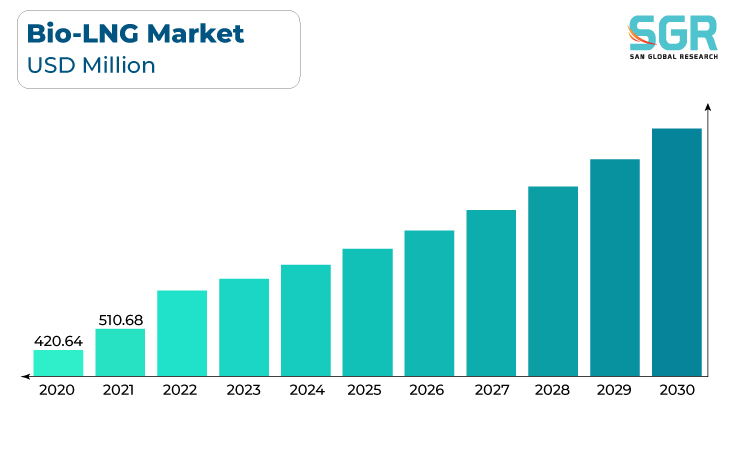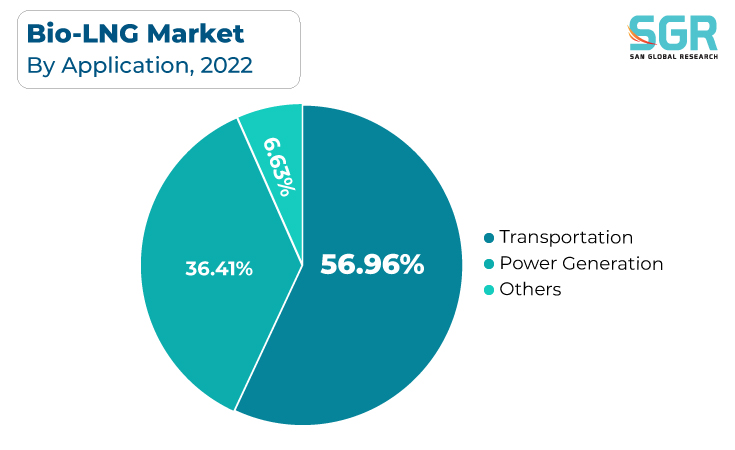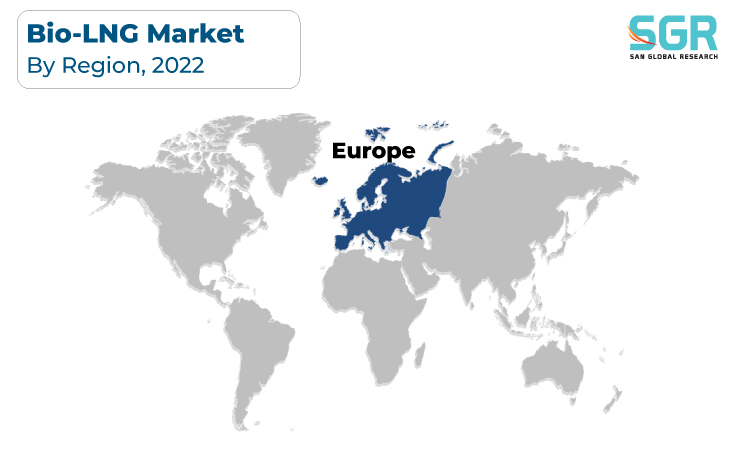Report Overview
The Bio-LNG Market was valued at 620.36 million in 2022 and expected to grow at CAGR of 35.64% over forecast period.

A combination of environmental sustainability imperatives and the transition to cleaner energy sources is driving the Bio LNG (Liquefied Natural Gas) market. Bio LNG, which is made from organic waste and renewable resources, is in line with global efforts to reduce greenhouse gas emissions and combat climate change. Environmental regulations and carbon-reduction targets are driving demand for low-carbon and renewable energy solutions, making Bio LNG an appealing alternative to traditional fossil fuels.

Furthermore, advances in production technology and increased investments in biofuel infrastructure are creating a favorable market environment for the growth of Bio LNG, as it provides a viable and cleaner energy option for the transportation, industrial, and residential sectors, contributing to a more sustainable and green energy landscape.
Application Outlook
Based on Application, the Bio-LNG Market is segmented Transportation Fuel, Power Generation, Others. Transportation segment accounted for largest share in 2022. The transportation bio LNG market is primarily driven by the need to reduce greenhouse gas emissions and mitigate the effects of climate change. With stricter environmental regulations and carbon-cutting targets in place around the world, there is a growing demand for cleaner, more sustainable fuel options. Bio LNG, which is produced from organic waste and renewable sources, is a lower-carbon alternative to traditional fossil fuels, making it an appealing choice for various modes of transportation such as trucks, buses, and maritime vessels.
The Power Generation Bio LNG market is driven by two goals: lowering carbon emissions and ensuring a reliable energy supply. Bio LNG, derived from organic waste and renewable feedstocks, plays a critical role in meeting these goals as the world shifts toward cleaner and more sustainable energy sources. It is an appealing option for grid stability due to its ability to provide a consistent and dispatchable source of power generation.
Source Type Outlook
Based on Source Type, Bio-LNG Market is segmented into Organic Household Waste, Organic Industrial Waste, Municipal Waste. Organic Household Waste accounted for largest share in 2022. Several key drivers are propelling the Organic Household Waste Bio LNG (liquefied natural gas) market. To begin with, growing environmental awareness and the need to reduce greenhouse gas emissions are driving demand for sustainable energy sources and waste management solutions. When organic household waste is converted into Bio LNG, it provides a renewable and low-carbon fuel source. Second, government incentives and regulations aimed at promoting renewable energy and waste-to-energy initiatives are encouraging investments in the production of Bio LNG from organic waste streams.

Bio LNG production and distribution are becoming a viable and cost-effective energy source, attracting both public and private sector investments due to advancements in technology and infrastructure. Finally, the potential for decentralized Bio LNG production from localized organic waste sources promotes energy resilience and reduces reliance on traditional fossil fuels, boosting the market's growth prospects even further.
Regional Outlook
Europe is emerged as leading market for Bio-LNG Market in 2022. Growing environmental awareness and stringent emissions regulations are driving the adoption of cleaner fuels, with bio LNG being a viable alternative due to its lower carbon footprint when compared to traditional LNG. Furthermore, increasing demand for sustainable energy solutions, particularly in the transportation and industrial sectors, is encouraging investments in bio LNG production and distribution infrastructure. Another driver is the availability of feedstock, such as organic waste and agricultural residues, which allows for the production of bio LNG with lower greenhouse gas emissions.
Several key drivers are propelling the Asia Pacific Bio LNG (Liquefied Natural Gas) market. To begin, the region's rising energy demand, particularly in rapidly developing economies such as China and India, is increasing interest in cleaner and more sustainable energy sources, with bio LNG offering a promising solution to reduce carbon emissions in a variety of sectors. Second, stringent environmental regulations and international climate change commitments are pressuring governments and industries to transition to lower carbon fuels, creating a favorable environment for bio LNG adoption.

Bio-LNG Market Report Scope
| Report Attribute | Details |
| Market Value in 2022 | USD 620.36 Million |
| Forecast in 2030 | USD 21.68 Billion |
| CAGR | CAGR of 43.69% from 2023 to 2030 |
| Base Year of forecast | 2022 |
| Historical | 2018-2021 |
| Units | Revenue in USD million and CAGR from 2023 to 2030 |
| Report Coverage | Revenue forecast, Industry outlook, competitive landscape, growth factors, and trends |
| Segments Scope | By Application, By Source type |
| Regions Covered | North America, Europe, Asia Pacific, CSA and MEA |
| Key Companies profiled | Titan LNG; DBG Group B.V.; BoxLNG Pvt. Ltd.; Shell Plc; Linde plc; Nordsol; Flogas Britain Ltd.; MEGA a.s.; AXEGAZ T&T; TotalEnergies; |
Global Bio-LNG Market, Report Segmentation
Bio-LNG Market, By Application
- Transportation Fuel
- Power Generation
- Others
Bio-LNG Market, By Source Type
- Organic Household Waste
- Organic Industrial Waste
- Municipal Waste
Bio-LNG Market, Regional Outlook
- North America
- U.S.
- Canada
- Mexico
Europe
- Germany
- UK
- Spain
- Russia
- France
- Italy
Asia Pacific
- China
- Japan
- South Korea
- Australia
CSA
- Brazil
- Argentina
MEA
- UAE
- Saudi Arabia
- South Africa

 Description
Description
 Table of Content
Table of Content
 Gera Imperium Rise,
Gera Imperium Rise,  +91 9209275355
+91 9209275355


